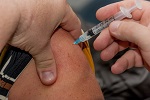
A place that may see an uptick in visitors in the future is one I would also like to see: the garden shed in which Edward Jenner gave the first vaccination to his gardener's 8-year-old son in 1796. Millions of lives were likely saved by mass vaccination in the COVID-19 pandemic, so we thought it would be appropriate to honor the man who started it all and visit the place where it began.
Jenner was born on May 17, 1749 in Berkeley, a small town between Bristol and Gloucester in England. At age 14, Jenner was apprenticed to a surgeon for seven years, then he continued his training at St. George's Hospital in London.
In 1772 at age 23, Jenner returned to Berkeley to establish his medical practice. Like most physicians at the time, Jenner performed variolation to prevent the deadly consequences of smallpox. Variolation involved collecting scabs from patients with a mild form of the disease. The scabs were ground up and inserted into the nose or under the skin of another patient, who would also develop the mild form of the disease. The mortality rate of variolation was below 2%, much lower than the 30% mortality rate of naturally acquired smallpox.
Jenner was aware of the stories that people who caught cowpox were resistant to smallpox. Cowpox is caused by a virus related to smallpox and it causes a mild infection of cattle. Milkers can catch the virus, which causes mild disease with small numbers of pox lesions on the hands and forearms. In May 1796, a milkmaid named Sarah Nelmes came to Jenner with a rash on her hands and arms. He determined that one of the cows Sarah milked, a Gloucester cow named Blossom, had a cowpox infection, and he also diagnosed Sarah with cowpox. He decided to use Sarah's case to test if cowpox protected people against smallpox.
On May 14, 1796, Jenner made scratches on James Phipps' arm, into which he rubbed some of Sarah's scab material. James became mildly ill and recovered in about a week. Jenner waited about six weeks before giving James smallpox variolation. James did not develop the disease. Jenner tested James several more times to establish that he was resistant to smallpox.
Jenner did many more such experiments and in 1798, he published his findings. Over the next two years, he published two more papers, establishing that inoculation with cowpox could protect against smallpox. The technique is now named vaccination, based on the Latin word for cow: vacca.
Not everyone believed in vaccination. Variolation was outlawed in England in 1840 and cowpox vaccination was made mandatory in 1853. These decisions led to protest marches and intense opposition from people who demanded freedom of choice. In 2022, vaccines are still the best way to prevent infectious diseases, yet opposition to vaccines continues despite two hundred years of experience showing they are safe and effective. So, I hope to visit the garden shed where it all began and celebrate all the lives that Jenner's discovery continues to save.
More Information
Britain's miraculous, life-saving garden shed
Before the pandemic, Dr Jenner's House - where the world's first vaccine was given - was an obscure tourism site. Post-Covid, it could become a major international attraction...
The Jenner Institute: About Edward Jenner
Edward Jenner was born in Berkeley, Gloucestershire on 17th May 1749. He was the eighth of the nine children born to the vicar of Berkeley, the Reverend Stephen Jenner, and his wife Sarah...
The Jenner Museum: History
In 1798, Edward Jenner published one of the most important documents in the history of medicine. It would save countless lives and change the way we respond to some of our most feared diseases...